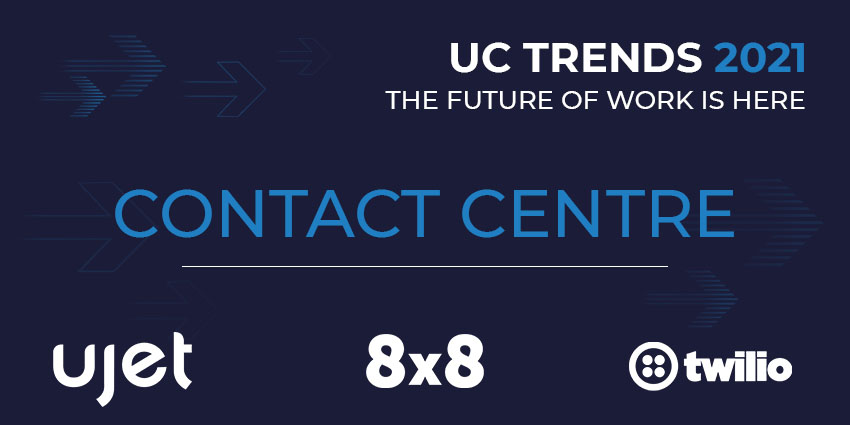The Contact Centre is a critical tool for any business. This meeting point between the brands and consumers is how companies build valuable relationships with their clients. However, it can also be a powerful factor in strengthening brand reputation, so that you can stand out from the competition.
With a powerful contact centre solution, companies can turn one-time customers into loyal repeat clients and brand advocates. Unfortunately, legacy tools can’t always deliver the results that customers are looking for. Around 90% of customers say they want immediate responses to their questions, which can be difficult to accomplish with some older tools.
As customer demand continues to evolve, and the way brands and clients interact transforms, the contact centre is changing at an astronomical pace. This is particularly true following the rise of COVID-19, which forced more contact centres to consider remote and distributed teams. Today, we’re speaking to experts from UJET, 8×8, and Twilio to get their insights into what contact centres will look like in 2021.
What Are the Most Significant Customer Trends from 2020?
The demand for flexible contact centre solutions is rising. Grandview research suggest that the market for contact centre software will reach a value of $72.3 billion by 2027.
Contact Centres as a Service, and solutions on the cloud are opening the door to endless new opportunities for businesses, and their customers. According to some reports, cloud contact centres even experience up to 35% less downtime than on-premise tools.
This year, we’ve seen various trends in the contact centre market, ranging from the rise of remote agents, to the increasing need for instant messaging and video. Here’s what our experts said about 2020’s leading trends.
Anand Janefalkar, Founder and CEO of UJET:

UJET’s CEO and Founder, Anand Janefalkar, told us that the most significant trend in 2020 has been the rapid evolution of remote work and life. This shift is fast-tracking the migration to cloud, and adoption of new technology. At the same time, it’s also accelerating demand for more mobile and digital channels.
“Another key trend from 2020 has been the significance of both scale and reliability, and more importantly, the two of them together. For some, 2020 has brought on the demand to rapidly scale, increasing team size without compromising on service. For others, scaling down has been a necessary part of streamlining their operations.”
Anand says that 2020 has shown us all that businesses need to be able to scale up and down rapidly, while still providing reliable customer interactions and experiences.
Chris Marron, Director of Competitive & Market Intelligence at 8×8:

Director of Competitive and Market Intelligence at 8×8, Chris Marron says that the biggest change we’ve seen is the rising demand for digital adoption in the home. People who would typically go into a store or use the phone are using digital media to interact with companies. This shift is particularly significant among older generations.
“Whether it’s reduced capacity in contact centres or agents working fully from home, the great home working experiment has forced customers to use digital channels either for the first time or as a way to access more services than they did before.”
Customers have shown a massive willingness to provide companies with patience in this new era, as brands shift into the online world. However, their patience is beginning to wear thin, according to Chris. “People are quick to compare their interactions with businesses that have switched to remote working well, and those who have yet to fully transition or – at worst – who are unresponsive even on digital channels.”
David Parry-Jones, Vice President of EMEA at Twilio:

Twilio’s Vice President of EMEA, David Parry-Jones, says that this year, the company has seen COVID-19 driving a massive digital acceleration and increased need for flexible platforms of customer engagement. There’s been a real demand for communication solutions that can scale quickly, deploy fast, and adapt, as necessary.
“Our latest research found that around 53% of businesses added new channels to their network during the pandemic. Around 1 in 3 began using live chat because of the pandemic. “This year it’s been more important than ever to ensure you’re reaching people on the channels they are comfortable using as everyone is grappling with a rapidly changing set of services”
On average, companies have accelerated their digital communications strategy by 6 years due to the pandemic. This isn’t something that’s just going to impact the short-term. Customer expectations remain unchanged, but companies are realising that they need to be flexible in the way that they communicate to meet their needs using suitable channels.
What are the Top Challenges Facing End Customers?
Companies in the new contact centre landscape are under excessive pressure to provide the experiences that their audiences want, without compromising on things like performance, affordability, or security. Though many businesses are making progress towards things like smarter, more diverse experiences, there’s still work to do.
Companies are still struggling to align the customer service offering across every available channel, while simultaneously responding to queries at speed. Liveops say that around two thirds of respondents in their study feel that they’re “behind the curve” on Contact Centre tech. We asked our business leaders what the most substantial changes facing end customers will be as we move forward into 2021. Here’s what they had to say:
Anand Janefalkar, Founder and CEO of UJET:
UJET’s founder and CEO told us that while companies are making significant progress towards a full and fluid omnichannel experience, the reality is that end-user solutions are still fragmented. As we head into the new year of 2021, companies will begin to tackle the challenge of mirroring agent experiences and fluidity for customers.
“Brands will begin to reduce the cognitive distance between the issue and the resolution, for both agents and customers”
Anand also noted that customers are using smartphones and mobile apps now more than ever. The biggest challenge will be to meet these customers where they are, through mobile chat and mobile web solutions, providing a contextual, rich, and modern experience for all.
Chris Marron, Director of Competitive & Market Intelligence at 8×8:
According to Director of Competitive and Market Intelligence for 8×8, Chris Marron, many contact centres were struggling with understaffing issues during lockdown, and afterwards. For many, this problem came from budget cuts and the rise of staff members on furlough. The challenge for customers now is that some contact centres are making it harder to get answers to questions.
Reducing connection options means that contact centres can avoid being overwhelmed. However, customers often suffer when they’re deflected towards FAQs and self-service chatbots. The chatbot solutions available from most companies today aren’t mature enough to handle complicated interactions.
“All this can really impact consumers’ trust in a brand, and so it’s important to ensure that whichever channels customers are being redirected to are as effective as possible”
David Parry-Jones, Vice President of EMEA at Twilio:
EMEA VP for Twilio, David Parry-Jones, said that siloes will continue to be a significant problem for customers in the current landscape, until companies can remove them completely from the experience. Clients want to be able to pick up a conversation a week after it began, using more than one channel, or even starting with a different department.
These customers don’t want to have to explain their query all over again. As businesses look to adopt new channels to handle the rapid digital shift, it’s going to be essential for them to have solutions that can remove causes of friction.
“Businesses need to ensure customer relationships aren’t damaged by a clunky, disconnected experience”
“With the flexibility of cloud-based contact centres that can assimilate and seamlessly link up a vast range of customer contact points, from email to chat, there’s no excuse for not doing this.”
Which Tech will Deliver the Greatest Value to Customers in 2021?
With various challenges to overcome, and opportunities to explore, the most innovative companies will turn towards technology to find solutions to their concerns. Already, immersive tools that feature machine learning, automation, and artificial intelligence are making a huge difference to the contact centre landscape.
Customers are also ready to embrace the presence of disruptive technology in contact centres. Salesforce found that around 57% of customers think that change is essential to ensuring the best client experiences. We asked our experts which pieces of tech they believe will deliver the most value in 2021. Here’s what they had to say.
Anand Janefalkar, Founder and CEO of UJET:
 CEO and Founder of UJET, Anand Janefalkar, said that data is king for the new digital and mobile world. It’s more essential now for companies to be able to capture data and create actionable steps and strategies from it. For the customer service landscape, this means combining data from the CRM and CCaaS environments.
CEO and Founder of UJET, Anand Janefalkar, said that data is king for the new digital and mobile world. It’s more essential now for companies to be able to capture data and create actionable steps and strategies from it. For the customer service landscape, this means combining data from the CRM and CCaaS environments.
“Data needs to be unified and contextualized, so agents have everything they need in a single interface to facilitate more natural, intelligent, and personalized interactions with customers.”
Chris Marron, Director of Competitive & Market Intelligence at 8×8:
Chriss Marron told us that the demand for remote working is here to stay. This means that unified communications platforms will be at the core of delivering excellent customer service in 2021. The majority of contact centre solutions will continue to provide remote working opportunities for staff following the pandemic.
“Investing in internal communications will be just as essential as communications channels with customers. We’re living in a time of great change, with policies evolving rapidly, sometimes on a daily basis, businesses need to quickly disseminate information across relevant stakeholders, customers, and agents.”
When a customer calls with a fringe case that normal processes can’t handle, companies will need to connect the entire organisation. This ability will be of greater value to brands than any new solution in the AI landscape. “Again, it’s having a single, unified communications platform that allows video, voice calls and chat with colleagues, as well as direct contact with the customer that will be crucial.”
David Parry-Jones, Vice President of EMEA at Twilio:
 Twilio’s David Parry-Jones told us that we’ve already seen a massive growth in demand for video in the last few months. This is a trend that’s expected to continue as businesses and customers make the switch to the digital-first world. The landscape is flexible and adaptable to different needs, whether companies want one-to-one interactions or group calls. Plus, there’s room for customisation.
Twilio’s David Parry-Jones told us that we’ve already seen a massive growth in demand for video in the last few months. This is a trend that’s expected to continue as businesses and customers make the switch to the digital-first world. The landscape is flexible and adaptable to different needs, whether companies want one-to-one interactions or group calls. Plus, there’s room for customisation.
“Since the pandemic, we’ve seen a 500% increase in daily Twilio Video usage and video minutes have almost tripled year-to-date.”
What’s Your Prediction for the Biggest Game-Changing Trend of 2021?
It’s impossible to know what any new year will bring. In 2019, no-one could have predicted the experiences that we would have in 2020. As we now begin to look towards the horizon of 2021, it’s difficult to know for certain what the future might bring. Right now, it seems as though there are plenty of opportunities for the contact centre.
The rise of video is an interesting trend that is likely to increase as customers search for ways to replace face-to-face interactions. Demand for artificial intelligence and analytics will allow companies to create more personalised experiences for their clients. At the same time, we’ll have more agents working at home from cloud-based tools that offer omnichannel support.
Here’s what our experts predict will be the biggest game-changing trends of 2021.
Chris Marron, Director of Competitive & Market Intelligence at 8×8:
 Moving from the remote work landscape as it exists during crisis times into a more sustainable strategy will be a massive step for a lot of businesses, according to Chris Marron. Remote working is becoming the centrepiece of many employees’ lifestyles, and it will force businesses to implement more effective long-term solutions.
Moving from the remote work landscape as it exists during crisis times into a more sustainable strategy will be a massive step for a lot of businesses, according to Chris Marron. Remote working is becoming the centrepiece of many employees’ lifestyles, and it will force businesses to implement more effective long-term solutions.
“Aside from implementing the technology needed to power a remote workforce, we will see the way businesses model themselves adapt to this new way of living. For example, if agents are able to work from home it doesn’t matter where in the country they’re based, opening up the talent pool businesses are able to recruit from. Similarly, we could see a rise in the gig economy.”
If companies only need a few agents to cover a short peak in demand, they might only hire freelancers to support those instances. Remote working has the potential to change the way we do business forever. Companies that can support seamless communication in this landscape will thrive.
David Parry-Jones, Vice President of EMEA at Twilio:
Twilio’s VP of EMEA said that the digital communication revolution has led to the arrival of a brand-new workplace, and the role of the office for the modern workforce. The rising and consistent need for remote and hybrid working is leading to a necessary adoption of highly flexible platforms for customer interaction.
“Both customers and customer service professionals switch up their working requirements from home, to office, to mobile where needed.”
Anand Janefalkar, Founder and CEO of UJET:
“2021 will see the widespread adoption of embeddable, data-driven, and personalized experiences that blend channels and modes of communication and unify customer journeys”
We’ll see how things such as multimedia sharing, and sending photos, videos, and screenshots to agents can help streamline experiences and increase resolution times. Smartphone biometrics and user authentication such as Face ID, thumbprint verification, or pattern recognition will become more commonly used ways for consumers to verify their identity, rather than the outdated questions like a mother’s maiden name, the name of your first-grade teacher, and more. These not only deliver a more modern customer experience, but they are also safer.
What do you think about the role of the Contact Centre in 2020? How do you think this environment will evolve? Join the conversation with us on social media.







